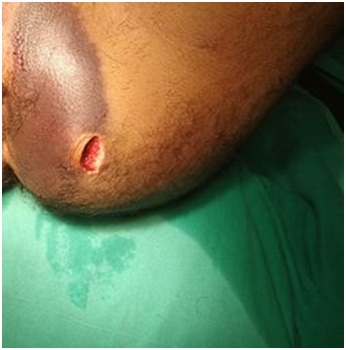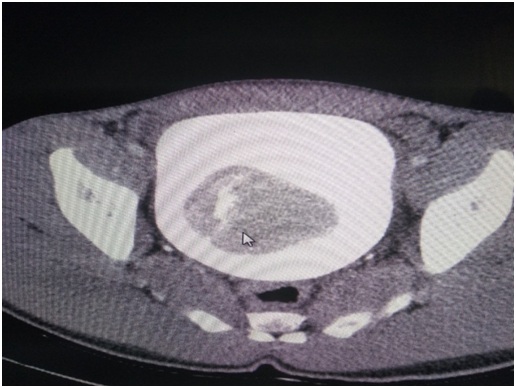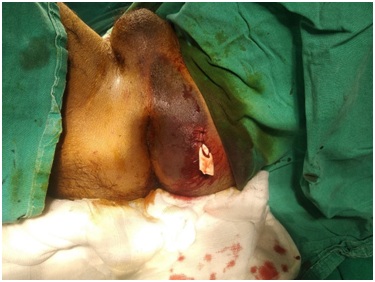
Isolated Bladder Injury Due to Stab Wound to the Buttock: A Case Report and Literature Review
*Corresponding Author(s):
Volkan Sarper ErikciAssociate Professor Of Pediatric Surgery, Department Of Pediatric Surgery, Tepecik Training Hospital, Saglik Bilimleri University, Izmir, Turkey
Tel:+90 232 4696969,
Fax:+90 232 4330756
Email:verikci@yahoo.com
Abstract
Stab wounds to the buttock are uncommon injuries and are rarely seen in children. Failure to detect these injuries and delay in therapy or inappropriate management of these cases may lead to serious morbidity and mortality. Herein, we report a 17-year-old boy who sustained a single buttock stab wound that was associated with isolated bladder injury. It is aimed in this report to remind the clinical and therapeutic features of this rare trauma together with a brief literature review on this issue. Bladder injury due to stab wound to buttock is a rare and unwanted complication of penetrating buttock trauma and should be treated accordingly.
Keywords
Buttock; Children; Stab wound
ARTICLE
Herein, we report an 17-year-old boy who sustained a single buttock stab wound that was associated with isolated bladder injury. It is aimed in this report to remind the clinical and therapeutic features of this rare trauma together with a brief literature review on penetrating bladder traumas due to stab wounds.
CASE

The patient looked well and was stable hemodynamically. Rectal examination under general anesthesia was found to be normal. An emergent urethrogram together with cystogram CT was done through a urethral catheter under screening which showed a huge intravesical hematoma and bladder contusion (Figure 2).

Examination under general anesthesia revealed a 3.5 cm wound with 15 cm in length in depth located 4 cm laterally to the anal opening and a perineal hematoma accompanied this lesion. Rectal examination revealed no abnormality and the wound was cleaned mechanically and devitalized tissues were removed and a pen-rose drain was inserted into the wound and anatomical closure with absorbable suture material was performed (Figure 3).

Bladder injury was managed by a urethral drainage. Oral feedings were started next day following operation and pen-rose drain was removed on the 7th postoperative day. After resolution of hematuria the foley catheter was removed on the 14th postoperative day. The patient is on our follow-up and totally asymptomatic with no urinary symptoms.
DISCUSSION
Penetrating injuries are commonly due to gun shots, stab wounds from a knife or other sharp objects or foreign body insertion into the urethra. It has been reported that gun shot wounds are responsible for the majority of penetrating bladder trauma compared to stab wounds (80% versus 20%) in the United States [6]. In a recent pictorial review, it has been reported that there has been an increasing trend over the past years for stabbings in the gluteal and perineal regions with an intention not to kill [3]. The incidence of bladder and urethral injury in buttock stab wounds is low accounting for only 2.6% of major injuries [7]. The stabbings into the gluteal and perineal region typically ocur in young, otherwise healthy usually male patients. This is a similar finding as the age of our patient presented in this study is 17 years.
There is a wide spectrum of lesions caused by these stabbing injuries ranging from only simple superficial injury to deep seated injuries leading to long-term complications for the patient. In the presented case length of the lesion was found to be 15 cm located near the rectum and bladder. Bladder wall disruption was found to be incomplete in the presented case during CT cystography and the lesion due to stab wound was regarded as bladder wall contusion showing an interstitial subtype of bladder injury. Despite this deep seated lesion, hopefully no major complication related to injury occurred in our case.
It has been reported that the site of the stab wound can help to determine the likelihood of severe underlying injury [3]. These injuries are divided as the “upper” and “lower” injuries by the intertrochanteric line. Upper zones were found to have sigificantly higher rates of severe injury than those of lower zone. Findings in our case are similar to this report and no significant morbidity was observed during follow-up of our patient.
Isolated bladder injury associated with penetrating stab wound into the buttock is very rare and most of these are due to gun shots. Most of stabbings into buttock include injuries to both rectum and bladder together. In bladder injury typically gross hematuria is a strong indicator of this trauma and cystogram should be performed [8]. CT cystography performed via urethra has the highest diagnostic accuracy. In order to detect a tiny bladder perforation, the area behind the bladder should be imaged after the contrast agent has been drained. CT cystography in our case did not show any extravasation of contrast agent in either filled bladder or post-evacuation cystographies but was helpful in detecting a huge intravesical hematoma probably secondary to bladder contusion. This hematoma was cleared via transurethral urine drainage with silicon foley catheter for 14 days.
In conclusion, penetrating buttock trauma is rare but may pose lethal consequences to the patient once it occurs. In order to avoid long-term complications, the possibility of urinary tract injury should be kept in mind in these patients and be appropriately and promptly managed.
ETHICAL CONSENT
REFERENCES
- Garcia VF, Sheldon C (1998) Genitourinary tract trauma. In: O’Neil JA, Rowe MI, Grosfeld JA, Fonkalsrud EW, Coran AG, eds. Pediatric Surgery, pp. 205-302.
- Nakayama DN (2004) Abdominal and genitourinary trauma. In: O’Neil JA, Grosfeld JL, Fonkalsrud EW, Coran AG, Caldamone AA, eds. Principles of Pediatric Surger. (2nd), Mosby, pp. 159-175.
- Campion T, Cross S(2017) The spectrum of injuries in buttock stab wounds. Clin Radiol 72: 543-551.
- Mahat Y, Leong JY, Chung PH (2019) A contemporary review of adult bladder trauma. J Inj Vioence Res 11: 101-106.
- Cestare TP, Hill FC, Venkatesan K (2015) Bladder Injury from Penetrating Trauma of the Inner Thigh. Urol Case Rep 6: 33-44.
- Zaid UB, Bayne DB, Harris CR, Alwaal A, McAnnich JW, et al. (2015) Penetrating trauma to the ureter, bladder and urethra. Curr Trauma Rep1: 119-124.
- Lunevicius R, Schulte KM (2011) Analytical review of 664 cases of penetrating buttock trauma. W J Emerg Surg 6: 33.
- Klein FA, Texter JH, Snoddy WJ (1980) Urologic injuries associated with penetrating wounds to the buttock. Va Med 107: 375-377.
Citation: Erikci VS (2019) Isolated Bladder Injury Due to Stab Wound to the Buttock: A Case Report and L?terature Rev?ew. J Emerg Med Trauma Surg Care 6: 031.
Copyright: © 2019 Volkan Sarper Erikci, et al. This is an open-access article distributed under the terms of the Creative Commons Attribution License, which permits unrestricted use, distribution, and reproduction in any medium, provided the original author and source are credited.

